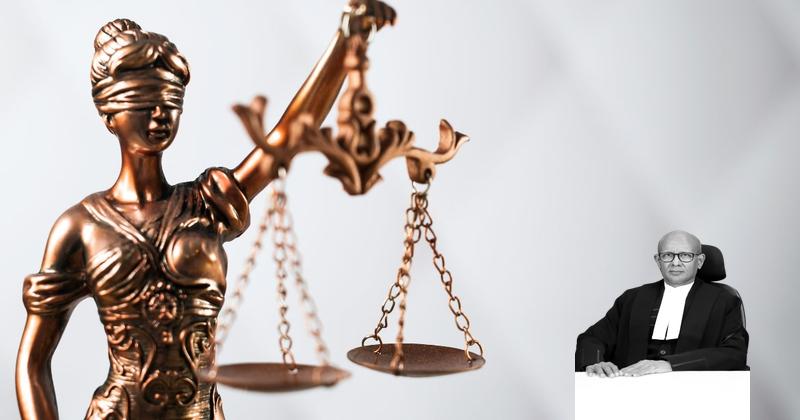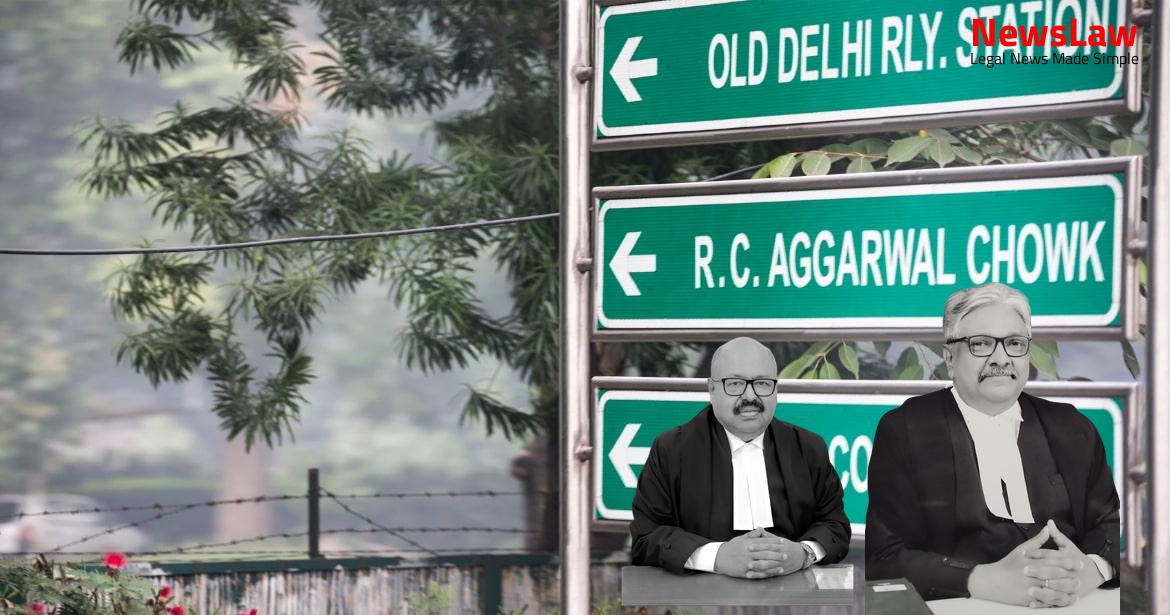Civil Appeal No 1544 of 2016 arises out of Civil Suit No 137 of 2010 and the tenant whose eviction is sought for in this suit is one Vasant Mahadeo Gujar (since deceased). On 23.01.2002, a demolition notice was issued by the Mahabaleshwar Giristhan Municipal Council for a part of the subject-building. 86- b situated within the municipal council, as on today that is 22-1-2002 it is found that the wall from the eastern side is swollen and there are cracks. Hence vide this notice it is to inform you to demolish the said dangerous portion immediately on receipt of this notice otherwise if any fatality occurs or the financial loss occurs due to the said house then municipal council will not be responsible and the entire responsibility will lie in your part. In the eviction notice to the respondent in Civil Appeal No 1544 5 of 2016, the grounds cited were, inter-alia, issue of the demolition notice by the municipality, default in payment of rent and also necessity of the tenanted portion for construction of a new building upon demolishing the structures on the land. His opinion has been referred to and dealt with by the Trial Court in the following terms:- “16) In this respect I have perused evidence of D.W.1 Vivek and his commission report at Exh.122. It is pertinent to note that in the commission report Exh.122, the commissioner has given actual position of every room situated in C.T.S.No.111/B. ‘C’ is demolished the entire roof on the property is also required to be removed and if said roof is removed it will create danger to the roof of the property on the western side and ta the roof on ‘B’ portion. The Trial Court also rejected the landlord’s contention that the subject- property was sublet or permanent structure was made without consent of the landlord. (1) A landlord shall not be entitled to the recovery of possession of any premises so long as the tenant pays, or is ready and willing to pay, the amount of the, standard rent and permitted increases, if any, and observes and performs the other, conditions of the tenancy, in so far as they are consistent with the provisions of this Act. 9 (4) Pending the disposal of any suit, the court may, out of any amount paid or tendered by the tenant, pay to the landlord such amount towards the payment of rent or permitted increases due to him as the court thinks fit. (1) Notwithstanding anything contained in this Act but subject to the provisions of section 25, a landlord shall be entitled to recover possession of any premises if the court is satisfied- (a) that the tenant has committed any act contrary to the provisions of clause (o) of section 108 of the Transfer of Property Act, 1882; Explanation.- For the purposes of this clause, replacing of tiles or closing of balcony of the premises shall not be regarded as an act of a causing damage to the building or destructive or permanently injurious thereto; or (b) that the tenant has, without the landlord’s consent given in writing, erected on the premises any permanent structure; Explanation.- For the purposes of this clause, the expression “permanent structure” does not include the carrying out of any work with the permission, wherever necessary, of the municipal authority, for providing a wooden partition, standing cooking platform in kitchen, door, lattice work or opening of a window necessary for ventilation, a false ceiling, installation of air-conditioner, an exhaust outlet or a smoke chimney; or (c) that the tenant, his agent, servant, persons inducted by tenant or claiming under the tenant or, any person residing with the tenant has been guilty of conduct which is a nuisance or annoyance to the adjoining or neighbouring occupier, or has been convicted of using the premises or allowing the premises to be used for immoral or illegal purposes or that the tenant has in respect of the premises been convicted of an offence of contravention of any of the provisions of clause (a) of sub-section (1) of section 394 or of section 394A of the Mumbai Municipal Corporation Act, or of sub-section (1) or of section 376 or of section 376A of the Bombay Provincial Municipal Corporations Act, 1949, or of section 229 of the City of Nagpur Municipal Corporation Act, 1948; or of section 280 or of section 281 of the 10 (2) No decree for eviction shall be passed on the ground specified in clause (g) of subsection (1), if the court is satisfied that, having regard to all the circumstances of the case including the question whether other reasonable accommodation is available for the landlord or the tenant, greater hardship would be caused by passing the decree than by refusing to pass it.
No decree for eviction shall be passed on the ground specified in clause (i) or (j) of sub-section (1), unless the court is satisfied- (a) that the necessary funds for the purpose of the erection of new building or for erecting or raising of a new floor or floors on the terrace are available with the landlord, (b) that the plans and estimates for the new building or new floor or floors have been properly prepared; (c) that the new building or new floor or floors to be erected by the landlord shall, subject to the provisions of any rules, bye-laws or regulations made by municipal authority contain residential tenements not less than the number of existing tenements which are sought to be demolished; (d) that the landlord has given an undertaking.- (i) that the plans and estimates for the new building or new floor or floors to be erected by the landlord include premises for each tenant with carpet area equivalent to the area of the premises in his occupation in the building sought to be demolished subject to a variation of five per cent in area; (ii) that the premises specified in sub-clause (i) will be offered to the concerned tenant or tenants in the re-er For the purposes of clause (m) of sub-section (1), the standard rent or permitted increase in respect of the part sub-let shall be the amounts bearing such proportion to the standard rent or permitted increases in respect of the premises as may be reasonable having regard to the extent of the part sub-let and other relevant considerations.
Notwithstanding anything contained in this Act, where the premises let to any person include- (i) the terrace or part thereof; or (ii) any one or more of the following structures, that is to say, tower-rooms, sitting-outrooms, ornamental structures, architectural features, landings, attics on the terrace of a building, or one or more rooms of whatsoever description on such terrace (such room or rooms being in the aggregate of an area not more than one-sixth of the total area of the terrace); or (iii) the terrace or part thereof and any such structure, and the court is satisfied that the terrace or structure or terrace including structure, as aforesaid, are required by the landlord for the purpose of demolition and erection or raising of a floor or floors on such terrace, the landlord shall be 14 entitled to recover possession of the terrace including such tower-rooms, sitting-out-rooms, ornamental structures, architectural features, landings, attics or rooms, the court may make such reduction, if any, in the rent as it may deem just. A suit for eviction on the grounds specified in clause (h), (i), (i) or (k) of sub-section (1) may be filed by the landlord jointly against all the tenants occupying the premises sought to be demolished.” The eviction proceeding was instituted in the suit giving rise to Civil Appeal No.1543 of 2016 against the appellants, inter-alia, on the grounds of having made construction of permanent nature by extending the area of the shop premises, without the landlords’ consent, causing permanent damage to the property in question, causing nuisance and annoyance to the adjoining area and neighbouring occupiers as also inducting a relative as sub- tenant.
Also Read: https://newslaw.in/case-type/criminal/quashing-of-criminal-complaint-in-commercial-dispute/
The Appeal Court has committed an error of law, apparent on face of record in interpreting Section 15 of the Rent Act, in the manner it has.
In the opinion of the High Court, it was incumbent on the part of the fact finding fora to come to a finding on that question and record satisfaction as required under sub- sections (4), (5), (6) and (7) of Section 16 of the 1999 Act. The High Court appears to have connected the claim based on reasonable and bona fide requirement to Sections 16 (1)(h) and (i) of the said statute. Dealing with claim based on Section 16(1)(h) and (i) of the 1999 Act, the statutory mandate for the Court is to test the question of part vacating.
The High Court rejected this finding, holding:- “54] However, the respondent-landlords, have not at all been candid with the Court insofar as the pleadings are concerned.
Even if, the premises subsequently acquired are left out of consideration, there was a duty upon the respondent-landlords to fully and candidly make disclosure about the premises in their occupation, both for the purposes of residence as well as commerce and thereafter to explain, howsoever briefly, the subsistence of the need in respect of suit premises. However, even on basis of the existing material on record, there was no question of making any decree under Section 16(1) (g) of the Rent Act.”
We affirm the view taken by the High Court that there was no satisfaction in the manner contemplated in Section 16 (2) of the 1999 Act as far as bona fide need in terms of Section 16(1)(g) was concerned. Section 16(1)(k) of the said Act permits recovery of possession of tenanted premises on the ground that the premises are required for immediate purpose of demolition ordered by any municipal or other competent authority. (1) If it shall at any time appear to the Chief Officer that any building or other structure or anything affixed to such building or structure is in a ruinous condition or likely to fall, or in any way dangerous to any person occupying, resorting to or passing by such building or structure or any other structure or place in the neighbourhood thereof, the Chief Officer may, by written notice, require the owner or occupier of such building or structure to pull down, secure, remove or repair such building, structure or thing or do one or more such things and to prevent all causes of danger therefrom. (3) If it appears to the Chief Officer that the danger from a building, structure or thing which is ruinous or about to fall is of hourly imminence he shall, before giving notice as aforesaid or before the period of notice expires, fence of, take down, secure or repair the said structure or take such steps or cause such work to be executed as may be required to arrest the danger.
But the High Court also found:- “76…Further, the notice is not directly in the context of suit premises occupied by the tenants, but rather pertains to certain portions of House No.86B.
Pursuant to such decision, the Municipal Authority, by notice dated 29 August 2002, notified the landlords that during inspection it was revealed that the landlords are illegally and unauthorisedly weakening the walls of House No 86 and that in future, if the wall collapses and causes loss to the life and property of the tenants, then, it is the landlords, who will be entirely responsible for the same.
Case Title: BAITULLA ISMAIL SHAIKH AND ANR Vs. KHATIJA ISMAIL PANHALKAR AND ORS. (2024 INSC 71)
Case Number: C.A. No.-001543-001543 / 2016



